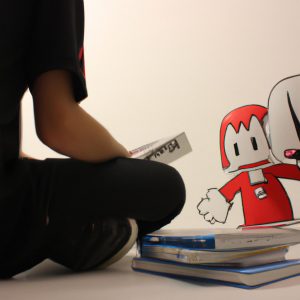Storyboarding in Arts and Comics: A Guide to Animation

Storyboarding is a crucial aspect of the animation process, serving as a visual blueprint that guides animators in bringing their ideas to life. Through carefully crafted sequences of drawings or digital images, storyboard artists are able to map out key scenes and actions, ensuring smooth transitions and effective storytelling. For example, consider an animated short film about a young girl who embarks on a magical adventure through a fantastical forest. The success of this narrative hinges upon detailed storyboarding techniques that capture the whimsy and wonder of each scene while maintaining coherence throughout the animation.
In both arts and comics, storyboard panels serve as essential tools for planning out visuals and conveying narratives effectively. By breaking down complex sequences into manageable frames, artists can structure their work in a way that engages viewers and maintains their attention. This article aims to provide aspiring animators with a comprehensive guide to storyboarding in arts and comics, exploring its importance within the animation industry and detailing practical steps for creating compelling storyboards. Drawing from academic research and professional expertise, it will delve into various aspects such as composition, camera angles, character positioning, dialogue placement, pacing considerations, and more. Whether one seeks to create animations for film or develop graphic novels filled with captivating illustrations, understanding the art of storyboarding is fundamental to bringing ideas to life and captivating audiences.
Storyboarding is essential because it allows animators and artists to visualize their concepts before investing significant time and resources into the actual animation or comic creation process. It helps in planning out the sequence of events, determining camera angles, framing shots, establishing character positions, and setting the overall tone and mood of a scene. By creating a detailed storyboard, artists can ensure that their storytelling is coherent, engaging, and visually appealing.
One crucial aspect of storyboarding is composition. Artists need to carefully consider how each panel will be framed to effectively convey the desired emotion or action. This involves selecting appropriate camera angles, determining the placement of characters and objects within the frame, and considering visual flow from one panel to another.
Character positioning is also vital in storyboarding as it helps establish relationships between characters and emphasizes their actions or reactions. By strategically placing characters within panels, artists can guide viewers’ attention and create dynamic compositions that enhance the narrative.
Dialogue placement is another important consideration in storyboarding for comics or animations that involve spoken words. Artists must determine where speech bubbles or captions will be placed within each panel to ensure readability without obstructing important visual elements.
Pacing considerations are crucial when storyboarding animated sequences or comic panels. Artists need to think about the timing of actions, transitions between scenes, and overall rhythm of the narrative. A well-paced storyboard creates tension, builds anticipation, and keeps viewers engaged throughout the animation or comic.
In conclusion, understanding storyboarding techniques is fundamental for aspiring animators and comic artists alike. It serves as a visual blueprint that guides the creative process by mapping out key scenes and actions while maintaining coherence throughout the animation or comic. Through careful consideration of composition, character positioning, dialogue placement, pacing considerations, and other aspects discussed above, artists can create compelling storyboards that bring their ideas to life in an effective and engaging manner.
What is Storyboarding?
Storyboarding is a crucial step in the process of creating animations, comics, and other visual narratives. It serves as a blueprint for the final product, allowing artists to plan out the sequence of events and visualize their ideas before bringing them to life. By breaking down complex stories into simpler panels or frames, storyboarding helps streamline the production process and ensures clear communication between creators and audiences.
To illustrate the importance of storyboarding, let’s consider an example. Imagine a team of animators working on an animated short film about a young girl who discovers a hidden magical world behind her bedroom wall. Without storyboarding, they would be faced with numerous challenges: how to effectively convey this fantastical journey within limited time constraints? How will each scene transition smoothly from one to another? Storyboarding provides answers to these questions by presenting a visual representation of each key moment in the narrative.
One way that storyboards evoke an emotional response is through their use of cinematography techniques. The careful selection of camera angles, lighting, and framing can greatly impact how viewers perceive a particular scene. For instance:
- A low-angle shot looking up at a character may make them appear powerful or intimidating.
- Soft lighting and warm colors could create a sense of comfort or nostalgia.
- Utilizing extreme close-ups can capture intense emotions or highlight important details.
- Fast-paced editing can build tension or excitement during action sequences.
In addition to evoking emotions through visuals, storyboards also allow creators to experiment with pacing and timing. By arranging panels in different orders or adjusting the duration of individual shots, artists have control over how quickly or slowly a story unfolds. This manipulation enables them to heighten suspense, emphasize comedic moments, or elicit specific reactions from viewers – ultimately enhancing their overall experience.
As we delve further into “The Importance of Storyboarding in Arts and Comics,” it becomes evident that this initial planning stage is not just helpful but essential for successful storytelling. Storyboarding serves as a foundation upon which artists can build their narratives, ensuring coherence and engaging audiences on both an intellectual and emotional level.
The Importance of Storyboarding in Arts and Comics
Building upon the understanding of what storyboarding entails, let us now delve into the significant role that storyboarding plays in the realm of arts and comics.
Storytelling through visuals is an integral part of animation, art creation, and comic production. Just as a well-structured narrative captivates its audience, a well-crafted storyboard serves as a blueprint for bringing ideas to life visually. To illustrate this point, imagine a scenario where an artist embarks on creating a comic strip without any prior planning or organization. The result may be disjointed panels lacking coherence or flow, making it difficult for readers to follow the intended message or storyline. However, by utilizing storyboards to plan out each frame meticulously, artists can ensure their artistic vision is effectively communicated.
A compelling reason for incorporating storyboarding into arts and comics lies in its ability to streamline the creative process and enhance productivity. By outlining scenes and sequences beforehand, artists gain clarity on composition choices, character positioning, and visual transitions between frames. This level of pre-planning minimizes guesswork during actual production while maximizing efficiency and minimizing revisions later on. It allows creators to focus more on refining their artwork rather than grappling with structural issues that could have been addressed earlier through storyboarding.
Furthermore, employing storyboards fosters collaboration among creatives involved in animated projects or comic productions. With a shared visual reference at hand, writers, illustrators, animators, directors – all team members – can collaborate seamlessly towards achieving a unified artistic vision. From ensuring consistent character designs across different episodes or installments to synchronizing actions within complex action scenes or establishing continuity throughout the storyline —a well-prepared storyboard facilitates effective communication amongst team members.
In summary…
As we have explored the significance of storyboarding in arts and comics,the next section will examine key elements crucial for crafting an impactful storyboard design.’
Key Elements of a Storyboard
Having established the significance of storyboarding in arts and comics, we now turn our attention to exploring the key elements that make up an effective storyboard. By understanding these essential components, artists and animators can create visually compelling narratives that captivate their audiences.
To illustrate the importance of incorporating these elements into your storyboard, let us consider an example scenario involving a comic artist named Sarah. Sarah is working on a graphic novel about her childhood adventures with her pet dog, Max. As she begins storyboarding one particular scene where Max gets lost at the park, she realizes the necessity of including several crucial aspects:
-
Composition: The layout and arrangement of each panel are vital for conveying emotions, creating suspense, or highlighting important details. For instance, Sarah decides to use close-up shots to emphasize Max’s facial expressions when he becomes scared while searching for his way back home.
-
Sequence: Ensuring a logical flow between panels helps maintain coherence within the narrative structure. Sarah opts for a sequential progression as she depicts Max initially wandering aimlessly before eventually discovering familiar landmarks that guide him towards safety.
-
Timing: Controlling pacing through timing allows creators to manipulate readers’ engagement levels by altering how long they spend observing each panel. In Sarah’s case, she employs longer pauses during moments of tension and quick transitions during high-action scenes.
-
Visual Style: Consistency in visual style enhances storytelling by establishing familiarity throughout the narrative journey. Sarah maintains consistency by using vibrant colors and bold linework consistently across all panels depicting Max’s adventure.
Incorporating these key elements effectively not only ensures clarity in communicating ideas but also immerses viewers in an emotionally resonant experience. When executed skillfully, storyboards can evoke various emotional responses from the audience, such as:
- Excitement: A dramatic scene with dynamic angles and bold action sequences fueling adrenaline.
- Tenderness: Delicate linework and soft color palettes evoking a sense of warmth and affection.
- Fear or Suspense: Strategic use of shadows, close-ups on characters’ fearful expressions, and eerie sound effects heightening tension.
- Nostalgia: Artistic choices that capture specific moments in time, triggering memories and nostalgia for the viewer.
To further illustrate these elements, here is a table showcasing different approaches to convey emotions through storyboard techniques:
| Emotion | Technique | Example |
|---|---|---|
| Happiness | Bright colors | Sunny background; smiling characters |
| Sadness | Dim lighting | Rainy atmosphere; somber expressions |
| Surprise | Dynamic composition | Unexpected camera angles |
| Intensity | High contrast | Strong highlights and deep shadows |
As artists continue to master these key elements within their storyboarding process, they gain the ability to seamlessly transport viewers into captivating narratives filled with emotion and visual appeal.
With an understanding of the crucial components involved in creating impactful storyboards established, we now delve into exploring various storyboard techniques and tools in our next section.
Storyboarding Techniques and Tools
In the previous section, we explored the key elements that make up a storyboard. Now, let’s delve into some techniques and tools commonly used in the process of creating storyboards for animation.
To effectively convey the narrative flow and visual composition of an animated project, artists employ various techniques and utilize specific tools. Here are three important techniques commonly employed in storyboarding:
-
Thumbnail Sketches: Artists often start by sketching small thumbnail drawings to quickly visualize different shots or scenes. These rough sketches allow them to experiment with compositions, camera angles, and character poses before committing to more detailed illustrations.
-
Shot Types and Angles: A wide range of shot types can be utilized in storyboarding to create dynamic visuals and communicate specific emotions or messages. For instance, extreme close-ups might intensify a character’s expression or emphasize an important object, while long shots could establish a sense of scale or setting.
-
Visual Continuity: Maintaining visual continuity throughout the storyboard is crucial for ensuring smooth transitions between scenes. Consistency in character proportions, lighting, color schemes, and overall style helps to create a cohesive narrative experience for viewers.
While these techniques play a significant role in crafting engaging storyboards, it is equally essential to have access to suitable tools designed specifically for this purpose. Below is a table outlining four popular software programs frequently used by animators and comic artists:
| Software | Features | Cost |
|---|---|---|
| Toon Boom Harmony | Advanced drawing & animation tools | High |
| Adobe Animate | Vector-based animation software | Moderate |
| Clip Studio Paint | Digital art software with animation capabilities | Moderate |
| Storyboarder | Free open-source software | Low |
The availability of such diverse options allows artists to choose tools that best suit their needs and budget, enhancing their ability to create visually captivating storyboards.
As we have explored the techniques and tools commonly employed in storyboarding for animation, let’s now move on to the next section: “Tips for Effective Storyboarding.” By implementing these tips, artists can further refine their skills and produce compelling storyboards that effectively convey their vision.
Tips for Effective Storyboarding
Storyboarding is a crucial step in the creation of animated films, comics, and other visual media. It serves as a blueprint for the entire project, allowing artists to visualize their ideas before bringing them to life. In this section, we will explore some effective techniques and tools used in storyboarding.
One technique commonly employed by storyboard artists is the use of thumbnail sketches. These small, quick drawings provide a rough representation of each shot or scene in the narrative. By focusing on composition and basic shapes rather than intricate details, artists can rapidly iterate and experiment with different ideas. For example, consider a hypothetical case where an artist is storyboarding a suspenseful chase sequence in an action comic. Through thumbnail sketches, they can easily test various camera angles and character positions to heighten tension and create dynamic visuals.
In addition to thumbnail sketches, digital software has become increasingly popular in modern storyboarding workflows. Programs like Toon Boom Storyboard Pro or Adobe Photoshop offer powerful tools that streamline the process. Artists can import reference images, add annotations, layer elements, and even create simple animations directly within these software applications. This integration between traditional drawing techniques and digital technology allows for greater flexibility and efficiency when crafting compelling narratives.
To further enhance storytelling through storyboards, here are some key considerations:
- Composition: Carefully composing each panel helps guide viewers’ focus towards important elements while maintaining visual interest.
- Pacing: Utilizing variations in panel size, shape, and placement can influence the pacing of the narrative.
- Visual Continuity: Ensuring smooth transitions between panels helps maintain coherence throughout the story.
- Emotional Impact: Selecting appropriate angles, lighting effects, and character expressions can evoke specific emotions from readers or viewers.
By employing these techniques and utilizing available tools effectively, storyboard artists can create visually engaging narratives that captivate audiences across various mediums.
| Composition | Pacing | Visual Continuity | Emotional Impact |
|---|---|---|---|
| Balancing elements within the frame | Varying panel sizes to control rhythm | Consistent visual language and flow between panels | Evoking specific emotions through visuals |
| Guiding viewers’ focus | Placement of action sequences | Maintaining consistent character appearances | Utilizing lighting, angles, and expressions |
With a strong foundation in storyboard techniques and tools established, we can now explore real-life examples that demonstrate how storyboarding is employed in arts and comics. This will provide further insight into the practical application of these principles and inspire artists to elevate their storytelling skills.
Examples of Storyboarding in Arts and Comics
Transitioning from the previous section, where we explored tips for effective storyboarding in arts and comics, let us now delve into examples that showcase the practical application of storyboarding in these creative mediums. To illustrate this concept further, let’s consider a hypothetical case study involving an animated short film.
Imagine a team of animators working on a project called “The Adventures of Alex.” The objective is to create a visually engaging and emotionally captivating storyline centered around a young protagonist named Alex who embarks on exciting adventures with their friends. Through meticulous storyboarding, the team carefully plans out each scene to ensure coherence and flow throughout the narrative.
To demonstrate how effective storyboarding can enhance visual storytelling, here are some key elements commonly found in successful storyboarded projects:
- Composition: Storyboards allow artists to experiment with different compositions and camera angles. By strategically placing characters within various frames, they can create dynamic visuals that convey mood, perspective, and depth.
- Timing: Effective use of timing is vital in animation. Storyboards help determine the pacing of scenes by indicating transitions between actions or shots, ensuring smooth continuity and enhancing dramatic impact.
- Emotion: Storyboards assist in capturing emotions through facial expressions, body language, and gestures. This enables artists to communicate character motivations effectively and engage viewers on an emotional level.
- Visual References: Storyboards often include reference images or notes about lighting conditions, color schemes, or specific visual details. These references guide both animators and other production departments involved in bringing the storyboarded concepts to life.
| Element | Description |
|---|---|
| Composition | Experimenting with different placements of characters for dynamic visuals |
| Timing | Determining pacing and transitions between actions |
| Emotion | Capturing emotions through expressions, body language, and gestures |
| Visual References | Providing guidance regarding lighting conditions, color schemes, or specific visual details |
Incorporating these elements into their storyboarding process, the team behind “The Adventures of Alex” successfully brings the imaginative world and characters to life. Through careful planning and attention to detail, they are able to create an animated short film that captivates audiences with its compelling visuals and emotive storytelling.
By examining examples like this hypothetical case study, we can see how storyboarding serves as a crucial tool in arts and comics, enabling creators to visualize their ideas effectively and communicate them to others involved in the production process.



